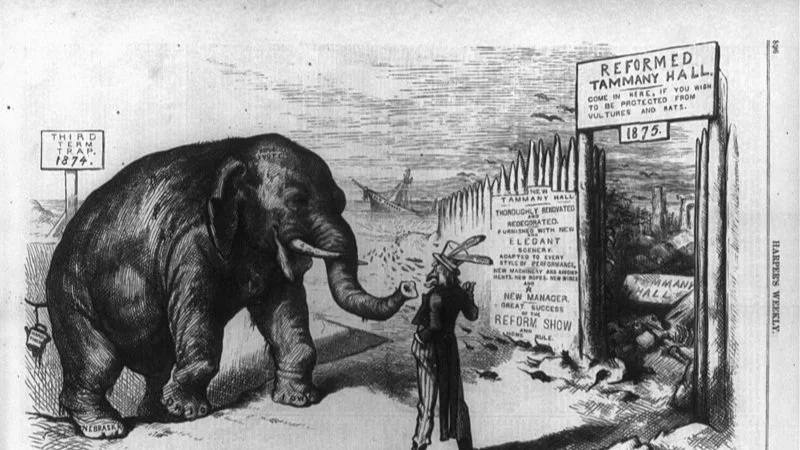Editorial cartoons have historically played a vital role in journalism, but are sadly being pushed out of the picture
Pulitzer Prize-winning editorial cartoonist Ann Telnaes resigned from The Washington Post after an editor killed a cartoon depicting wealthy businessmen and leading media figures, including Jeff Bezos, who owns The Post, paying obeisance to President-elect Donald Trump.
It is a sharp, honest jab at the powerful. That’s the role of an editorial cartoonist, and it has been a valuable item in the journalistic toolbox for decades.
In recent years, however, the number of artists who make their points primarily with images on opinion pages has declined sharply. It’s a major loss to newspapers and their readers, but the moneychangers who control the industry either don’t know that or, more likely, don’t care.
In July 2023, the McClatchy Media Co., which owns 29 daily newspapers and several other smaller community papers, fired three Pulitzer Prize-winning cartoonists on the same day. Jack Ohman of the Sacramento Bee, Joel Pett of the Lexington Herald-Leader and Kevin Siers of the Charlotte Observer were all dropped.
“I had no warning at all,” Ohman told The Associated Press. “I was stupefied.”
Pett said there was no chance for him to continue.
“I could have looked at the guy who fired me and said, ‘I’ll do it for free,’ and they would have said no,” he told a reporter.
Ohman, a Minnesota native, has been drawing witty and pointed cartoons for more than four decades. He has been nationally syndicated since he was 19, and was at The Oregonian, which has a very loud voice in Portland and Oregon politics and culture, for more than three decades.
I am a longtime fan, and attended a newspaper convention in Oregon in the early 1990s where Ohman spoke and explained his work and vision. It was a rare thing — a compelling presentation at a newspaper convention.
Editorial cartoons have long fascinated me. The great Thomas Nast, “The Father of the American Cartoon,” brought down the incredibly corrupt William Magear “Boss” Tweed and his Tammany Hall machine in New York City .
Tweed tried to bully and bribe Nast, who reportedly turned down $500,000. Nast’s beautifully drawn and witty cartoons informed citizens, many of whom struggled to read English, of the blatant theft that was occurring. (Editor’s note: One of those Nast cartoons is seen above in a public domain image posted on wikimedia commons.)
“I don’t give a straw for your newspaper articles,” Tweed said, “Most of my voters can’t read. But they can’t help seeing them damned pictures.”
Boss Tweed fled the country when the heat was turned up. He was arrested in Spain, and Nast cartoons were used to help identify him. That is the power of the pen.
When I was in high school, I read “The Tiger’s Tail: A Story of America’s Great Political Cartoonist Thomas Nast.”
At SDSU, I was amazed to learn the author, Nancy Veglahn, taught English there. She was a kind, funny, inspiring teacher, and I haunted her classrooms for years.
Other significant artists who left a mark by creating memorable images on opinion pages include three-time Pulitzer winner Herbert Block, who signed his work Herblock for 55 years at The Washington Post. His famous cartoon of heavily bearded Richard Nixon crawling out of a sewer stuck in people’s minds.
Rube Goldberg, Ed Valtman, Art Wood, Paul Conrad, Pat Oliphant and many others delighted readers, left politicians sputtering and added a major contribution to newspapers.
When I was a student journalist at SDSU, I was incredibly fortunate to be given the opportunity to interview the legendary Bill Mauldin. We met in the Student Union cafeteria, and after I bought a couple Cokes, he was kind enough to put up with my fumbling efforts.
Mauldin won two Pulitzer Prizes in his career and numerous other awards in a half century as a cartoonist. He got his start as a soldier in World War II, where he created his famous characters “Willie and Joe,” a pair of unshaven, war-weary infantrymen.
It made him famous, as his fellow soldiers embraced the realities Mauldin depicted with his pen. Some generals were less happy, including the bombastic George S. Patton, who threatened to toss Mauldin in jail, terming him an “unpatriotic anarchist.”
Thankfully, commanding Gen. Dwight D. Eisenhower ordered Old Blood and Guts to leave Mauldin alone. The soldiers loved his work, and needed that outlet, Ike realized.
Mauldin, who was just 23 when he won his first Pulitzer in 1945, returned home after the war and enjoyed a long career as an editorial cartoonist. He won a second Pulitzer in 1959, and created perhaps his most famous cartoon in the wake of President John F. Kennedy’s assassination in 1963.
It showed the statue of Abraham Lincoln, seated at the Lincoln Memorial, with his head in his hands in grief. I talked with Mauldin about that image. Wish I could find that story.
When I was at The SDSU Collegian, we always had a cartoonist on staff, and they were a talented bunch, including Randy Medema, Carolyn Nyreen and Russ Peterson.
Mauldin died in 2003 at the age of 81. Like other war heroes, he was buried at Arlington National Cemetery. But his work, and Willie and Joe, live on.
My friend and colleague Andy Jacobs created outstanding editorial cartoons for The Rapid City Weekly News during its brief, shining run from 2005-09. I first became aware of Andy’s artistic brilliance when we worked at The Duncan Banner in Oklahoma in 2005. When I was hired to help start The Weekly News, I asked to bring Andy along.
One of our supposed bosses saw his talents and wanted to switch him to advertising design, but when we said that wasn’t why we came to Rapid City, that idea was quickly dropped.
For the next 40 months, Andy drew cartoons that elicited laughter from our readers and staff, caused some politicians to sweat and moan and told the truth with a few strokes of his pen. I spent a night drinking and talking politics with Dusty Johnson in Pierre, and he said he was a fan of Andy and The Weekly News. Other politicians admitted to the same admiration for our work.
I have worked with other talented cartoonists over the years, some who were on the staff, others who contributed to the paper. There are still a few around, and The Black Hills Pioneer has published many locally produced cartoons over the years.
More papers need to retain or recruit cartoonists. It’s becoming a lost art, and that is a shame.
There’s not even a category for them in the Pulitzers, which last honored a cartoonist, Jim Morin of the Miami Herald, in 2017. The category is now called “Illustrated Reporting and Commentary.”
It seems like editorial cartoons are like the buggy whip, liberal Republicans and CD players. Once vital, now assigned to the ash heap.
“There’s a broader reluctance in this political environment to make people mad,” said Tim Nickens, retired editorial page editor at the Tampa Bay Times in Florida, told a reporter. “By definition, a provocative editorial cartoonist is going to make somebody mad every day.”
That’s the job, along with making them laugh and think. It is — well, was — an important part of newspaper journalism.
Fourth-generation South Dakotan Tom Lawrence has written for several newspapers and websites in South Dakota and other states for four decades. He has contributed to The New York Times, NPR, The London Telegraph, The Daily Beast and other media outlets. Do not republish without permission.







